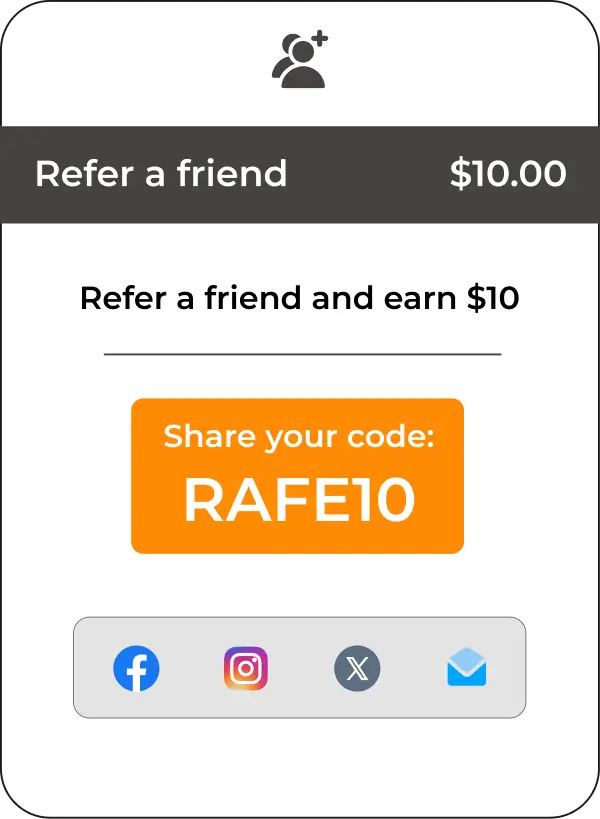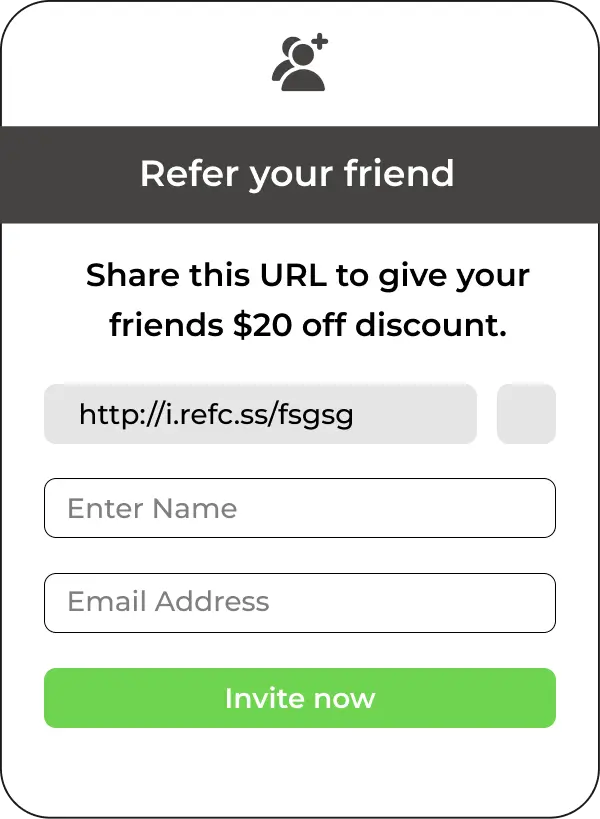Table of Contents:

Referral marketing has become one of the most powerful strategies for businesses in the digital age. It’s not just about gaining new customers but building a loyal customer base that actively promotes your product or service. One of the essential tools in referral marketing is the referral code, a unique code that customers share to get rewards for bringing in new business.
Referral programs can lead to exponential growth. In fact, a well-executed referral program can generate higher conversion rates and bring in customers who are more likely to engage with your brand. With the rise of social media and digital platforms, referral codes are a seamless way to track these valuable customer referrals.
At its core, a referral code is a unique string of numbers or letters assigned to each participant in a referral program. These codes are used to track customer referrals and reward customers who share their experiences with others. When a potential new customer uses the code during sign-up or checkout, the system recognizes the code and attributes the referral to the customer who provided it.
A referral code is more than just a discount or promotional offer—it’s a way to tap into a customer’s personal network. It turns your satisfied customers into advocates who can earn rewards for bringing in new customers. The concept of referral codes has evolved over time from simple word-of-mouth recommendations to sophisticated, technology-driven programs that are integrated into businesses’ marketing strategies.
Although both referral codes and referral links aim to improve customer acquisition, they differ significantly in terms of functionality, user experience, and use cases.
Referral Codes are alphanumeric characters that customers enter manually during checkout or sign-up. These codes are unique to each individual and serve as identifiers when tracking referrals. They add a personal touch, making them ideal for vocal referrals, such as when someone reveals the code during a podcast or discussion. However, the need for manually signing up might provide challenges: customers may forget to use the code or enter it improperly, resulting in missed rewards and tracking discrepancies. Despite these disadvantages, referral codes are flexible and effective in cases when digital sharing is not a possibility.

Referral Links, on the other hand, are URLs containing a referral code included. When the link is clicked, the code is automatically used during the sign-up or checkout process, resulting in increasing efficiency. This removes the need for manual entry, reduces error rates, and improves the overall user experience. Referral links are easy to share through social media, emails, or messaging apps, making them ideal for digital marketing campaigns. Furthermore, these offer complete insights on clicks, shares, and conversions, which improves tracking accuracy. However, referral links might seem less personal compared to codes and may not be as effective in audio-visual modes where spoken recommendations are preferred.

Both systems have unique advantages. Referral links are user-friendly, especially in online settings, whereas referral codes offer a more customized and flexible option for offline engagement. The choice between the two should be based on your program’s specific goals, target demographic, and sharing context. Many businesses successfully use both strategies to increase awareness and engagement across multiple channels.

Referral codes work by creating a link between a customer and their referred friend. The process of using referral codes can be broken down into four essential steps:
When a customer wants to refer a friend or colleague, they share their unique referral code. This code can be shared in a variety of methods, including email, text, social media, and in person. Many businesses use referral program software to generate these codes and links, making it easy for their customers to share them.
When a referred friend or family member uses the referral code during sign-up or while making a purchase, the system can identify that a new customer has been referred. This allows the referral to be attributed to the correct customer.
Tracking is essential to ensuring that referral codes are correctly recorded. Most businesses use software that can automatically track when a code is used and link the referral with the correct account. This process enables businesses to properly credit the customer who made the referral.
When the referred person completes the required activity, such as making a purchase or signing up, both the referrer and the referred typically receive benefits. These benefits can include discounts, credits, and even cash bonuses.
Creating effective referral codes involves a strategic approach, leveraging technology, and focusing on customer experience. By ensuring a seamless and rewarding process, businesses can encourage participation and drive growth. Here’s a detailed look at each step:
Using third-party platforms such as 99minds makes it easier to create and manage referral programs. These tools provide features such as automated code generation, referral tracking, and reward distribution. They also offer detailed analytics, allowing businesses to monitor program performance and optimize initiatives.
Customization options allow brands to design their referral programs to their brand identity, resulting in a consistent and professional customer experience. Integrating these technologies with eCommerce platforms such as Shopify can help streamline operations, making it easier to create and manage a successful program.
A referral program’s success depends on how easy it is to share. Customers are more likely to participate if they can easily share their referral codes or links through email, social media, or messaging apps. Providing one-click sharing options improves ease and encourages referrals.
Furthermore, providing shareable templates or pre-written messages can help customers efficiently promote the program. Ensure that the referral links and codes are mobile-friendly, as many people share material through smartphones. The easier and more accessible the process, the more likely customers are to engage and share the word.
The rewards you provide should appeal to your target audience. Generic incentives may spark initial interest, but personalized and relevant rewards build long-term engagement. Discounts, store credits, free products, and exclusive experiences are all effective incentives.
Consider a tiered rewards program in which customers earn higher-value rewards for more referrals, with a gamification aspect to encourage ongoing engagement. Exclusive or limited-time rewards may also create a sense of urgency, resulting in quicker action. Businesses that link rewards with customer interests will build loyalty and drive more successful referrals.
Clarity is essential for a successful user experience. Clearly explain how customers can join the referral program, share their coupons, and track their earnings. Create step-by-step guides, frequently asked questions, or short instructional videos to walk users through the process. Customers should understand what actions both the referrer and the referee must take to claim their incentives.
Providing regular updates and status notifications can help participants stay engaged and informed. Clear instructions reduce friction, build trust, and make customers feel comfortable promoting your brand through recommendations.
Let’s take a closer look at some top examples of companies that use referral codes successfully:
Dropbox’s referral program became a model of effective customer acquisition. When existing users invite friends using their unique referral code or link, both parties receive additional storage space. For instance, each successful referral typically grants the referrer and the new user 500MB of extra cloud storage. This method incentivized millions to share Dropbox, significantly boosting its user base during its early stages.
Uber’s referral system offers ride credits to both referrers and new users. When an existing rider shares their referral code with a friend, the new user receives a discount on their first ride. Once the friend completes the trip, the referrer earns a ride credit. This program effectively drives organic growth by rewarding loyal customers and encouraging new user sign-ups.
Airbnb’s referral program provides travel credits, creating mutual benefits for both referrers and referees. Existing users share a referral code with friends, who then receive a discount on their first stay. When the new user completes their first booking, the referrer earns travel credits for future trips. This approach encourages sharing and helps Airbnb build a global community of travelers.
Google Pay uses monetary incentives to promote its app. Users can share their referral codes with friends, and when a new user completes their first transaction, both parties receive cash rewards directly in their accounts. This simple yet effective strategy accelerates user acquisition and encourages repeated use of the platform.
Revolut’s referral program offers bonuses when existing users invite friends. After signing up and completing specific actions, such as making a transaction, both the referrer and the new user receive monetary rewards. This approach ensures that new users actively engage with the platform, boosting customer retention and growth.
Referral codes are an invaluable tool for businesses looking to expand their reach and build a loyal customer base. They provide an opportunity to tap into word-of-mouth marketing, leveraging your existing customers to bring in new ones. With the right setup, a well-executed referral program can significantly increase your customer acquisition and retention rates.
As the digital landscape continues to evolve, referral codes will remain a key driver in marketing strategies. By understanding how they work, creating effective programs, and applying best practices, businesses can unlock new levels of growth and success.
99minds offers you the tools and strategies to make the most of referral marketing, helping you design and implement successful referral programs that drive business growth.
